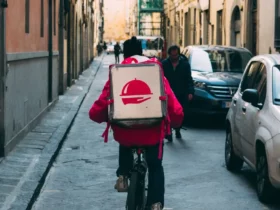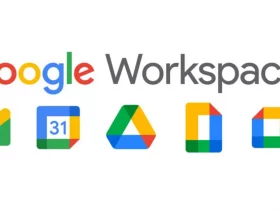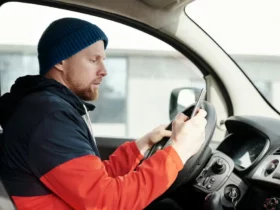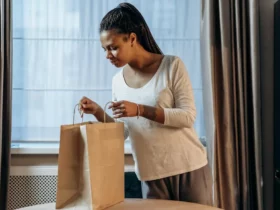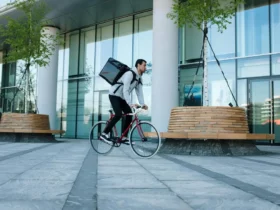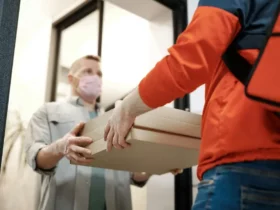Ever found yourself craving a meal but not wanting to step out? That’s where Uber Eats comes in handy. It’s a game-changer for food delivery, letting you order from your favorite local spots right from your phone. And if you’re on the other side as a driver, you’re part of a growing platform that’s expanding by over 150% each year.
As an Uber Eats driver, I’m always on the lookout for ways to snag the biggest orders and boost my earnings. It’s not just about being on the road; it’s about working smart. With Uber Eats being a major player in the delivery game, holding a quarter share of the US market, there’s plenty of opportunity to make your time count. Let’s dive into some insider tips to help you get more orders and maximize your profits.
Mastering Uber Eats: A Comprehensive Guide
Exploring the Dynamics of Uber Eats
I’ve learned that understanding the Uber Eats platform’s ins and outs is crucial for anyone looking to maximize their earnings as a driver. It’s more than just an app; it’s a vast network connecting restaurants, customers, and drivers like me. Here’s the scoop: the app simplifies food ordering by allowing users to conveniently choose from a wide array of local eateries. With a few taps on their smartphone, they can have meals delivered right to their doorstep.
Order fulfillment on Uber Eats involves several steps that I follow meticulously. When an order comes in, my tablet’s screen lights up green, accompanied by an audible alert. It’s vital for me to interact with the device promptly to accept the order. Once accepted, preparation begins, and I track this progress through visual cues as the order icon moves from a receipt to a pan and, eventually, to a bag that tells me it’s ready for delivery.
Maximizing Order Volume: The Key to Success
In my quest to increase order volume, I always make sure that my personal touch as a driver isn’t lost in the rush. Establishing a rapport with both the restaurant staff and customers and ensuring I’m easily reachable can make a big difference. When faced with multiple orders from the same restaurant, known as ‘batched orders’, I grab the opportunity to reduce waiting time and deliver more in one go.
How do I ensure I don’t miss any orders? First, I keep the volume up on my tablet so I hear every single notification. Secondly, efficient use of my time is paramount. If I ever can’t reach a customer, Uber Eats starts a countdown timer; knowing the next step ahead of time keeps everything on track without unnecessary delays. And let’s not forget the basics – setting my favorite map app makes my routes more efficient, shaving off valuable minutes that stack up through the day.
Beyond individual orders, paying attention to broader trends pays off. Certain restaurants may have higher-priced items or promote ordering in bulk, leading to larger tips. I’ve become somewhat of an aficionado in identifying which places are likely to yield more profitable deliveries.
Lastly, knowing the local area is indispensable. I’m always scouting for restaurants that cater to families or groups since they often order more. It’s a numbers game, and I’m playing to win. Much like the new Priority Delivery option – for an additional charge, customers can have their meals arrive sooner. It’s another chance for drivers like me to turn a quick turnaround into better earnings.
Strategies for Restaurants
Menu Optimization
When I look at making my menu more attractive on Uber Eats, it’s not just about the food items I offer; it’s about how I present them in the app. High-quality images and detailed descriptions can make all the difference. I regularly check my menu on restaurant.uber.com and make necessary updates. Logging in, changing cooking times, or adding new, tantalizing dishes ensures that my offerings stay fresh and appealing to customers. It’s also crucial to keep my opening hours updated in the app to avoid any customer frustration.
Enhancing Food Presentation
Even after the best menu optimization, it’s the food presentation that can win or lose the game. I take pride in ensuring that each dish not only tastes incredible but also looks impeccable when it leaves the kitchen. For packaging, I select materials that maintain food temperature and appearance. It’s all about creating a visual appeal that makes customers order again and again. After all, when food arrives looking great, it’s more likely to be photographed and shared on social media, offering free marketing for my offerings.
Utilizing Promotions and Discounts
To boost my visibility on the platform, I sometimes use promotions and discounts. Strategic discounts during lower sales periods help to increase orders and introduce new customers to my restaurant. I’m careful not to undercut my profits but rather use these as opportunities to attract customers who may turn into regulars. Periodic promotions also encourage larger orders, so I plan them to coincide with events or holidays when people are more likely to eat together.
Managing Customer Reviews and Ratings
Reputation on Uber Eats heavily relies on customer feedback. Hence, managing reviews and ratings is a top priority. I encourage satisfied customers to leave positive reviews, which can elevate my restaurant’s standing on the platform. Additionally, responding to negative feedback respectfully and promptly is crucial. It not only shows that I’m proactive about customer service but can also turn a poor experience into a loyal customer if handled correctly. Keeping a high rating increases my chances of appearing earlier in search results, which can significantly influence the number of orders I receive.
Tips for Individual Drivers
Understanding Your Area and Market
Gaining an edge as an Uber Eats driver starts with really getting to know my market. Familiarity with the neighborhoods I deliver in can drastically affect my profitability. I’ve learned that choosing the right area is crucial—it’s not just about the number of restaurants but also the types of restaurants available.
Here’s the breakdown:
- Family-oriented neighborhoods or affluent areas often yield higher-paying orders.
- A mix of casual, semi-casual, and fine dining options increases the range of potential delivery fees.
By assessing the demand within various parts of the city, I’ve managed to position myself in zones that offer the best prospects for bigger orders and better tips.
Timing Your Availability
I’ve realized that timing absolutely influences the quality and quantity of orders I receive. Driving during peak meal times, such as lunch and dinner rushes, naturally means more activity and a higher volume of potential deliveries.
Here’s what I keep in mind:
- Prime times such as weekends, holidays, or during local events can significantly boost my earnings.
- Staying flexible and adapting to the flow of business, especially during these peak periods, keeps my efficiency up.
An important strategy I’ve picked up is to monitor the Uber Eats app for new incentives and promotions that can pop up at any moment—especially during these key times.
Utilizing Metrics for Efficiency
Efficiency isn’t just about how fast I drive; it’s about making smart choices based on available data. I’ve started paying close attention to the metrics that the Uber Eats driver app provides to refine my delivery process.
Here are some strategies I implement:
- Reverse cherry-picking orders: accepting lower offers for shorter drives can quickly accumulate into a reasonable hourly rate.
- Watching the visual timer on delivery offers helps me gauge how quickly I need to make a decision.
- Prioritizing orders based on dollar amount, restaurant location, and distance ensures that I minimize time spent on the road for lesser profits.
Making informed decisions based on these real-time metrics often means the difference between an average and an outstanding earnings day for me.
Advanced Strategies and Tools
Providing Exceptional Customer Service
I’ve learned that a driver’s attitude can be just as important as speed when it comes to successful deliveries. A warm greeting and a sincere ‘thank you’ can leave a lasting impression on customers leading to higher ratings and possibly more tips. It’s not just about getting the food from point A to B; it’s the small, human touches that can differentiate me from others. I make sure to communicate effectively, not just with customers but also with restaurant staff. Being courteous goes a long way and can sometimes smooth over unexpected delays.
Knowledge of Restaurants and Menus
I’ve got to admit knowing the restaurants I pick up from is a game-changer. Familiarizing myself with menus, particularly which items are high-end or popular, gives me an edge. I ask myself which restaurants have items that likely lead to larger orders or more tips. Skipping a guess and using my knowledge to prioritize certain pickups can really beef up my earnings. As I don’t see item details until after accepting the order in the Uber Driver app, understanding restaurants’ clientele and menu pricing beforehand becomes critical. It’s a strategic move that has paid off more often than not.
Managing Stacked Orders
Stacked orders can be a gold mine or a time sink, and I’ve learned to tell the difference. I use tools and apps like Upper Route Planner to manage these optimally. With just a few clicks, I can organize multiple delivery paths and ensure that I’m delivering each order efficiently. This not only improves my work output but also goes a long way in providing a quality customer experience, even when the orders are backed up. Handling stacked orders successfully requires a balance of speed and smart route planning, and with the right approach, they can significantly increase my earnings.
Practical Tips for Uber Eats Drivers
The life of an Uber Eats driver is all about getting from point A to point B efficiently, providing excellent service to customers, and managing time effectively. I’ve learned a few key strategies along the way that have made my delivery experience more rewarding and less hectic.
Efficient Order Handling and Delivery
For me, efficiency starts with order handling. I make sure to review the order details as soon as they come in, checking for any special instructions or requests. Handling food with care is critical, so I always verify that the order matches what’s shown in my Driver app before I leave the restaurant. This saves time and avoids backtracking. Additionally, staying organized with insulated bags and drink carriers proves invaluable, especially when handling multiple orders.
Communication and Transparency with Customers
One of my top priorities is maintaining clear communication with my customers, which in turn fosters transparency. I shoot them a quick text if I’m running late or if I encounter any issues. I find that customers really appreciate updates about their food’s whereabouts, and it can lead to better ratings and sometimes even bigger tips.
Navigating and Time Management
Efficient navigation is vital for timely deliveries, and time management is an ongoing challenge. I plan my route ahead and try to be mindful of the time of day and traffic patterns, which could impact my estimated arrival times. Cultivating knowledge of local shortcuts and street layouts often shaves minutes off each journey.
Utilizing Technology for Efficient Routing
I’ve grown reliant on navigation apps to guide me through the quickest routes. I make sure my app settings are optimal for driving conditions, and I update my preferences to avoid tolls or highways when that’s the faster option. These little adjustments, enabled by today’s technology, can significantly affect my order completion rate.
Balancing Order Density and Travel Distance
I’m always calculating the balance between accepting a high volume of orders and the travel distance required. While it’s tempting to take on multiple orders to maximize earnings, it’s not always the best move if they’re scattered too far apart. I aim for a sweet spot where I can manage several close proximity deliveries in one smooth loop. This strategy helps me to use my time and fuel more efficiently, leading to a more profitable shift.
Mastering the Uber Eats delivery process means embracing these strategies to streamline operations and deliver the best possible service to customers. I’m constantly refining my approach as I gain more insight from each delivery experience.
Conclusion
‘ve spilled the beans on how to get more orders on Uber Eats and make each delivery a success. Remember, it’s all about being quick on your feet, staying in touch with your customers, and using tech to your advantage. Keep those wheels turning, balance your orders smartly, and you’ll see the difference in no time. Here’s to delivering smiles and satisfying those food cravings, one order at a time!
FAQ – Frequently Asked Questions
How can I increase the number of orders I get on Uber Eats?
To boost order requests, consider changing the time of day you go out to align with peak meal times such as lunch (around 12 pm to 2 pm) and dinner (starting before 5 pm and sometimes extending until 7 pm). Being online before these rush hours can be advantageous. Additionally, positioning yourself closer to areas with high restaurant density and avoiding areas with too many delivery people can help.
What should I do if I’m not receiving any orders as a driver?
If you’re experiencing a lull in orders, try going offline and then back online in the Uber Eats app. This simple action can sometimes refresh your status and lead to new order requests. It’s also beneficial to be adaptable and ready for unexpected situations, such as changes in weather, which can increase demand for food delivery services.





